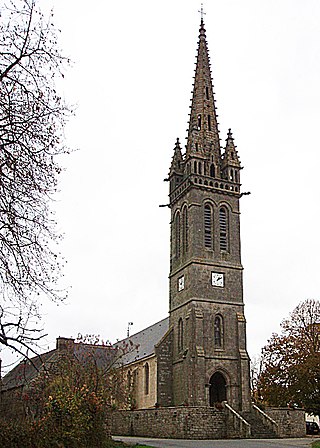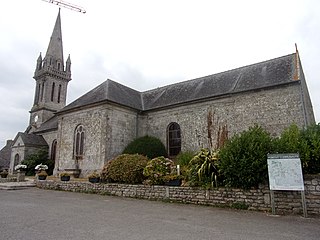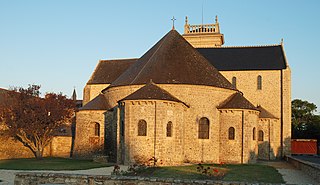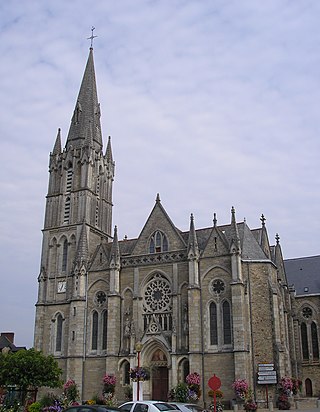Life
Bieuzy was, it is said, a native of Great Britain who migrated to Brittany, and there became a hermit and a disciple of Saint Gildas. [2] Tradition relates that in the year 538 Bieuzy went up the Blavet valley in the company of Gildas (who had previously founded the monastery [ fr ] of Saint-Gildas-de-Rhuys): they established a hermitage or oratory consisting of a natural cave in a huge pile of rocks on the banks of the Blavet near Castennec. [3] [4] A few years later, Gildas returned to Rhuys, but Bieuzy remained, setting up a school nearby, around which a few inhabitants settled, at a place which has since become the village of Bieuzy. The establishments created by Gildas and Bieuzy were destroyed during the Norman invasions in the 9th or 10th century. [5] Gildas and Bieuzy's oratory was refounded in the 16th century as the Chapelle Saint-Gildas. [6] Saint Bieuzy became known as a holy healer of rabies, locally called le mal de Saint Bieuzy. [7]
According to the hagiographer Guy Autret de Missirien, Saint Bieuzy performed a curious miracle. Around 570, a servant asked him to interrupt his mass to go and heal his lord's pack of dogs suffering from rabies, but Bieuzy refused. The furious Breton lord came to split his skull with a sword (an axe, knife or cutlass according to other versions of the legend), the blow being so violent that the weapon remained planted there. Bieuzy found the strength to walk 80 kilometres (50 mi) to the abbey of Rhuys where he died under the blessing of his master, Saint Gildas. During his journey to the abbey, Bieuzy is said to have spent a night in Bieuzy-Lanvaux (near Pluvigner) with the axe still embedded in his skull. The spring of Bieuzy-Lanvaux has since this event been under the protection of the holy healer of rabies and migraines. The legend also tells that the Breton lord, on his return home, found that all his horses and farm animals had gone mad; the dogs bit the tyrant and his servants to death. [8]
Stained-glass representations of Saint Bieuzy at Église Notre-Dame,
Bieuzy 
Brittany is a peninsula, historical country and cultural area in the west of modern France, covering the western part of what was known as Armorica during the period of Roman occupation. It became an independent kingdom and then a duchy before being united with the Kingdom of France in 1532 as a province governed as a separate nation under the crown.

Morbihan is a department in the administrative region of Brittany, situated in the northwest of France. It is named after the Morbihan, the enclosed sea that is the principal feature of the coastline. It had a population of 759,684 in 2019. It is noted for its Carnac stones, which predate and are more extensive than the Stonehenge monument in Wiltshire, England.

Lorient is a town (commune) and seaport in the Morbihan department of Brittany in western France.

The Gulf of Morbihan is a natural harbour on the coast of the department of Morbihan in southern Brittany, France. Its English name is taken from the French version, le golfe du Morbihan, though it would be more precisely called 'the Morbihan' as its Breton name 'Ar Mor Bihan' means 'the little sea'., as opposed to the Atlantic Ocean outside,. Legend says that there are as many islands in the Gulf as there are days of the year. In fact the gulf has about 40, depending on the tides. Many islands are private property, except the largest two, Île-aux-Moines and Île-d'Arz.

Île-d'Arz is an archipelago of nine islands and a commune in the Morbihan department, Brittany, northwestern France, only 6 kilometres to the southwest of Vannes.

The arrondissement of Lorient is an arrondissement of France in the Morbihan department in the Brittany region. It has 58 communes. Its population is 312,063 (2016), and its area is 1,461.8 km2 (564.4 sq mi).

The arrondissement of Vannes is an arrondissement of France in the Morbihan department in the Brittany region. It has 99 communes. Its population is 279,964 (2016), and its area is 2,416.2 km2 (932.9 sq mi).

The Bretons are a Celtic ethnic group native to Brittany. They trace much of their heritage to groups of Brittonic speakers who emigrated from southwestern Great Britain, particularly Cornwall and Devon, mostly during the Anglo-Saxon settlement of Britain. They migrated in waves from the 3rd to 9th century into Armorica, which was subsequently named Brittany after them.

Bieuzy is a former commune in the Morbihan department in Brittany in northwestern France. On 1 January 2019, it was merged into the new commune Pluméliau-Bieuzy. Inhabitants of Bieuzy are called Bieuzyates.

Bignan is a commune in the Morbihan department in Brittany in northwestern France.

Quistinic is a commune in the Morbihan department of Brittany in north-western France. It is twinned with the rural village of Loughshinny in County Dublin, Ireland.

Séglien is a commune in the Morbihan department of Brittany in north-western France.

Saint-Gildas-de-Rhuys is a commune in the Morbihan department of Brittany in north-western France. Inhabitants of Saint-Gildas-de-Rhuys are called in French Gildasiens.
Saint Felix of Rhuys was a Breton Benedictine hermit and abbot, who re-founded Saint-Gildas-de-Rhuys Abbey.

Missillac is a commune located in the department of Loire-Atlantique in western France.
Waroch I was an early ruler of the Bro Wened (Vannetais) in southern Brittany. It is unclear whether he or his grandson Waroch II is the namesake of the region.

The sieges of Vannes of 1342 were a series of four sieges of the town of Vannes that occurred throughout 1342. Two rival claimants to the Duchy of Brittany, John of Montfort and Charles of Blois, competed for Vannes throughout this civil war from 1341 to 1365. The successive sieges ruined Vannes and its surrounding countryside. Vannes was eventually sold off in a truce between England and France, signed in January 1343 in Malestroit. Saved by an appeal of Pope Clement VI, Vannes remained in the hands of its own rulers, but ultimately resided under English control from September 1343 till the end of the war in 1365.
Golfe du Morbihan - Vannes Agglomération is the communauté d'agglomération, an intercommunal structure, centred on the city of Vannes. It is located in the Morbihan department, in the Brittany region, northwestern France. It was created in January 2017 by the merger of the former Communauté d'agglomération Vannes Agglo with the former communautés de communes Loc'h Communauté and Presqu'île de Rhuys. Its area is 807.4 km2. Its population was 169,785 in 2018, of which 53,438 in Vannes proper.
Olivier Delourme (1660–1729), nicknamed "the architect of Brittany", was a French architect of the "Grand Siècle" renowned for his many achievements still existing, mainly in Morbihan.
This page is based on this
Wikipedia article Text is available under the
CC BY-SA 4.0 license; additional terms may apply.
Images, videos and audio are available under their respective licenses.
![Statue of St Bieuzy in the Eglise Notre-Dame [fr], Bieuzy, Morbihan Bieuzy (56) Eglise Notre-Dame Interieur 08.JPG](http://upload.wikimedia.org/wikipedia/commons/thumb/a/a2/Bieuzy_%2856%29_%C3%89glise_Notre-Dame_Int%C3%A9rieur_08.JPG/220px-Bieuzy_%2856%29_%C3%89glise_Notre-Dame_Int%C3%A9rieur_08.JPG)

















